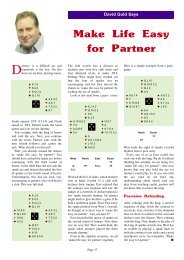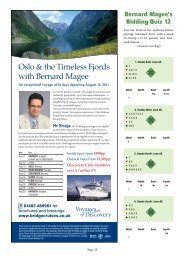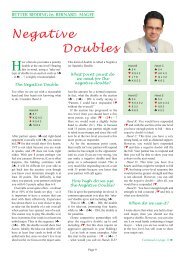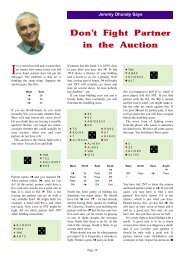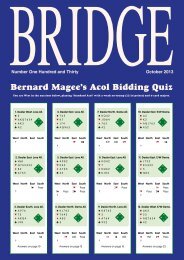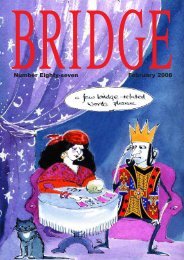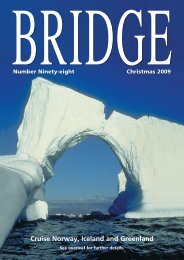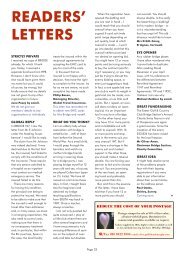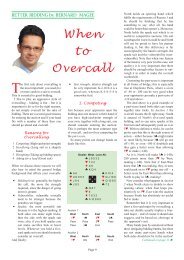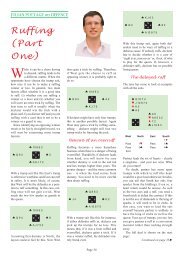You also want an ePaper? Increase the reach of your titles
YUMPU automatically turns print PDFs into web optimized ePapers that Google loves.
BETTER BIDDING by BERNARD MAGEE<strong>Bidding</strong> slams is not easy, butthere is no doubt that biddingand making a slam is one of thegreat joys of bridge. The first importantelement in slam bidding is trying toidentify when a slam might be on.Basic identification<strong>Slam</strong>s are a lot easier to make if youhave a big trump fit, because you canmake extra tricks by trumping and so donot have to rely on high cards alone.However, no-trump slams are rather different:you almost always need to relyon a high number of points between you.The points needed for a 6NT contractare about 33 between the partnership,whilst for a suit contract, when you havea good fit, you are basically looking forno more than a combined 30 and thatincludes length and distribution.Adding on for length and shortagecan be difficult when you are getting tothe slam level and thus the Losing TrickCount is a great help when you have abig fit: it evaluates the whole shape ofyour hand. Although the LTC is not part<strong>Slam</strong><strong>Bidding</strong><strong>Part</strong> Iof the approach followed in this article,readers who use this method of evaluationshould stick with it, and when it suggeststhat a slam might be on, they shouldexplore its possibility.Note that although you may have 30points between you (or the Losing TrickCount might suggest that a slam is on),but without the necessary controls (aces,kings, singletons and voids), you maystill not be able to make a slam – thereis plenty of checking to be done!Let us look at some examples ofidentification:Layout A♠ A K 5 2 ♠ 4 3♥ A K 6 5 4 2 N ♥ Q J 10 3W E♦ K 6 S ♦ A Q J 3♣ 4 ♣ 9 7 6Opener1♥?Responder3♥When your partner bids 3♥, your handDUPLICATE BRIDGE BOARDSStickers included. Cards not included1-8 set. £22.501-16 set. £37.50BIDDING BUDDYPacks into a compact space. Ideal for use at home.£7.50 each. 4 for £28.95Available from the Mail Order Service 01672 519219leaps in value because you have a fit. Youhave 17 high-card points, can add twofor your excellent long suit and also twofor your singleton (with the long trumps);that makes a total of 21. Your partner’sbid shows 10-12 points so that puts thepartnership in the range of 31-33, whichcertainly has slam potential, and thereforeyou should try for slam. A 4♥ bidwould finish the auction, so West mustdo something else to try to find a slam.We will discuss the conventions availablein the forthcoming two articles.Layout B♠ A 10 4 2 ♠ K Q J 6♥ 9 6 4 N ♥ A K 5 3W E♦ A 9 7 2 S ♦ K 4♣ A8 ♣ K 5 3Layout C♠ A10 ♠ K Q J 6♥ 9 6 4 N ♥ A K 5 3W E♦ A 9 7 2 S ♦ K 4♣ A 8 4 2 ♣ K 5 3To see how things differ between suitcontracts and no-trump contracts, take alook at Layouts B and C, where the Easthand is the same. The Wests in both layoutshave the same point-count andshape, the only difference being the cluband spade suits.This changes their potential alongsidethe East hand in a big way: East-West inLayout B can play in 6♠ with a reasonablechance of making the contract byruffing two diamonds. But in Layout CEast-West do not have a fit and thereforehave to play in no-trumps; with noruffing to supply extra tricks, there arejust ten tricks off the top with chances tomake an eleventh if hearts or clubs break3-3. Notice that East-West hold all theaces and kings in Layout C, but in notrumpcontracts you need more than justaces and kings: you need the queens andjacks too, to make the extra tricks. Inthe layout above the jack of spades isjust as valuable as the ace – they willboth make a trick.Once you have identified that a slammight be on, how do you decide whetherto go for it?The answer is: by using the variousconventions that are available, whichshould include an ace-asking bid.Continued on page 10 ❿Page 9
BETTER BIDDING continued from page 9Conventions forfinding slamsI recommend the following:Key-card BlackwoodCue-biddingSplintersQuantitative BidsGrand <strong>Slam</strong> ForceThe Gerber (4♣) convention is omittedbecause to employ cue-bidding andsplinter bids you need to use the 4♣ bidfor other purposes. Over the next twoarticles I will be covering these aspectsof slam bidding. If after seeing themyou don’t fancy employing them, thenyou could stick to Gerber, but otherwiseyou should steer clear of using Gerber.Key-card BlackwoodBlackwood is the best method for slamexploration. It is no coincidence thatalmost all bridge players use some formof this convention: it is simply one ofthe best ideas in bridge – without theaces, slams cannot be made.I recommend using Key-card Blackwood– it works exactly like normalBlackwood except that you count theking of trumps as an ace. The idea isthat the king of trumps is a very importantcard (as important as any ace) sothat it should be included in your Blackwoodcalculations, e.g. with spades astrumps the key-cards are: ♣A, ♦A, ♥A,♠A and ♠K.The beauty of this convention is thatthe responses are almost exactly the sameas normal Blackwood:5♣5♦5♥5♠0 or 4 key-cards1 (or 5) key-cards2 key-cards3 key-cardsHALF CUBE JOTTING PADfrom the£4 50CODE AF01Mail Order Service 01672 519219The only change is that the 5♦ responseis used to show five key cards as well asthe normal one; the five option will notcome up very often and, rather like thedifference between 0 and 4, there shouldnever be a problem differentiating betweenthe two possibilities.You will see that this addition to theBlackwood convention is invaluable foraccurate slam bidding and yet, at thesame time, there is nothing new to learnother than to remember to count the kingof trumps in the responses!There are two common fears withtaking on this new convention:1. How do you know which suit istrumps?2. How do you know whether partnerhas the aces or the king of trumps?The trump suit should be obvious; infact, you should never use Blackwoodunless you have agreed a suit, or you arehappy to play in the last-bid suit.For example, in the auction 1♥ –4NT, hearts would be trumps, but moreusually there will be explicit agreementwhen both sides have bid the same suit:in the sequence 1♠ – 3♠ – 4NT, spadesare trumps. So, if there is doubt about thetrump suit, then the last-bid suit should bethe one you use. Remember that if youare aiming for a no-trump slam, then acesand kings are not so important and youvery rarely need to ask about them. Moreimportant is the number of points youhold and, as you will see, we willconsider quantitative bidding later.The answer to question 2 is that itdoesn’t matter! The king of trumps isjust as valuable as an ace so if you aremissing any two of the five key-cards,you would not want to be in a slam.It is time to look at some examples:Layout D♠ 10 3 2 ♠ 4♥ K 9 5 3 N ♥ A Q J 7 2W E♦ A 7 6 4 S ♦ K Q J 5♣ A6 ♣ K Q 4West3♥5♠EndEast1♥4NT6♥East opens 1♥ and after his partner’s3♥ response he re-evaluates his hand:18 high-card points, a strong five-cardsuit (worth one extra point) and asingleton (with the long trumps, worthtwo points). That makes 21 points;adding this total to his partner’s 10-12means East is definitely excited aboutthe prospects of a slam.When contemplating the use ofBlackwood, you need to make surethat you will know what to do afterany response.Here East is basically missing fourimportant cards: the ace of spades, theking of hearts, the ace of diamonds, andthe ace of clubs. He can find out aboutall these cards by using Key-cardBlackwood. If partner has two, he willsign off in 5♥; if partner has three, hewill go for 6♥, and if West has four,East would go for a Grand <strong>Slam</strong> (thislast option is not really likely as Westhas limited himself to 10-12 points).Responding to 4NT, West must rememberto include the king of trumps(here hearts) in his response. He hasthree key-cards: the ace of clubs, the aceof diamonds and the king of hearts, andso he responds 5♠. Now East carriesout his plan and bids 6♥. He bids it withgreat confidence because he knows aboutthe king of trumps as well as the numberof aces.Compare this with the auction belowon Layout E, where West holds the kingof spades instead of the king of hearts asin Layout D:Layout E♠ K 3 2 ♠ 4♥ 10 9 5 3 N ♥ A Q J 7 2W E♦ A 7 6 4 S ♦ K Q J 5♣ A6 ♣ K Q 4West3♥5♥East1♥4NTEndOnce again East starts a Blackwoodsequence, but this time West only showstwo key-cards (5♥): the king of spadesdoes not come in to the reckoning, it isonly the king of trumps that is included.Continued on page 11 ❿Page 10
BETTER BIDDING continued from page 10Over 5♥ East passes; missing two keycards,slam is not a good proposition. Itmight appear that the slam will makehalf the time, but the chance of a void indiamonds brings it just below 50% andtherefore not a good slam. You shouldtry to avoid a slam if you are missingtwo key-cards.Let’s look at another couple of hands:Layout F♠ A K 8 5 4 2 ♠ Q 7 6♥ Q 7 6 N ♥ 4W E♦ A6 S ♦ K Q J 5 3♣ A2 ♣ K Q J 3West1♠3♠5♣EndEast2♦4NT6♠West opens 1♠ and East bides his timeby responding 2♦; there is no need tohurry, since opener will always bid againif you have changed the suit at the twolevel. West rebids 3♠, showing a six-cardsuit and a strong hand. Now the time hascome for East to get excited: with excellentsupport for spades he should reevaluatehis hand: 14 HCP, a strong fivecardsuit (worth an extra point), and asingleton along with the short trumps(worth three points); that all adds up to18 points. West has suggested 16 or morepoints himself, which means the side’stotal points are at least 34, which is wellinto the slam range. Now you, as East,have to ask yourself whether Blackwoodis the best method for exploring a slamwith your hand. Once again the answeris yes, because you are simply in needof the five key-cards: all the aces andthe king of spades (trumps). Thus, ifpartner has three, you would settle for5♠; if he has four, you would go for 6♠,and if he has all five, you would go for7♠ (or perhaps even 7NT).You leap to 4NT, which agrees spades(the last-bid suit) as trumps, and yourpartner responds 5♣; this shows zero orfour aces. Can you partner have zero? Ifhe held no key-cards, then the only highcards he could hold are the jack of spadesand the king, queen and jack in hearts –clearly that does not add up to 16! Hemust have four key-cards and thereforeyou bid 6♠.Change the West hand slightly, as inLayout G, and you would avoid 6♠:Layout G♠ A J 8 5 4 2 ♠ Q 7 6♥ K J 10 N ♥ 4W E♦ A6 S ♦ K Q J 5 3♣ A2 ♣ K Q J 3West1♠3♠5♠East2♦4NTEndThe bidding starts the same way but nowWest has only three key-cards (the ♥Kdoes not count), so he bids 5♠, whichEast would pass. Even if South holds theking of spades, the ten of spades mightmake a trick anyway. It is certainly not aslam you would want to be in.What does 5NT mean?It is important to note that you only usethe king-asking bid if your side has allfive key-cards, as after 5NT you have tobe in a small slam (any response will beat the six-level!) and thus your aspirationsnow should be for a grand slam. Icannot emphasise this enough.Only bid 5NT if you think there isa chance of a Grand <strong>Slam</strong>.So, essentially, a 5NT bid is a Grand<strong>Slam</strong> Try.It is rarely important to know thenumber of kings your partner holds, morecommon is the need to know which kinghe holds. Hence the response shouldshow any king you hold in your hand(below the trump suit).With two kings outside trumps, bid6NT (or the Grand <strong>Slam</strong>). And with ahand where you think you can make aGrand <strong>Slam</strong> (knowing that all the keycardsare held) bid the Grand <strong>Slam</strong>.Finally, with a hand which does not wantto accept the Grand <strong>Slam</strong> Try (e.g.without any kings to show), bid six ofthe trump suit.Here are three West hands to partnerthe same East:Layout H♠ K J 4 3 ♠ A 10 9 8 6 2♥ A 9 7 6 2 N ♥ K 8W E♦ K 3 S ♦ A Q J 2♣ A4 ♣ 2West1♥3♠5♠6♦EndEast1♠4NT5NT7NTAfter West raises to 3♠, East has a slamin mind: 14 HCP + 2 (for six-card suit)+ 2 (singleton with long trumps) = 18.West has shown a better than minimumopening hand, say 15-17 points, leavingyou with at least 33 points between you.Blackwood should be able to solve yourproblems, and there is rather good newsbecause West’s 5♠ response shows thethree missing key-cards. With everythingin place, there is surely a chance for aGrand <strong>Slam</strong> if opener holds the ♦K. SoEast bids 5NT and West responds 6♦showing the ♦K. East can now countthirteen tricks and thus bid 7NT.Continued on page 13 ❿WASHABLE CLUB CLOTHSGreen Cherry Navywith with withsymbols symbols symbols(BC10) (BC09) (BC08)£22 50Available from the Mail Order Service 01672 519219Page 11
BETTER BIDDING continued from page 11Layout I♠ K J 4 3 ♠ A 10 9 8 6 2♥ A 9 7 6 2 N ♥ K 8W E♦ 8 3 ♦ A Q J 2S♣ AK ♣ 2West1♥3♠5♠6♣EndEast1♠4NT5NT6♠The auction proceeds the same way ason Layout H, but this time over 5NT Westbids 6♣, showing the king of clubs.There is no way you can underwrite aGrand <strong>Slam</strong> now, so you settle for 6♠ –it was the king of diamonds fitting withthe diamond suit that allowed East topush on to the Grand <strong>Slam</strong> in Layout H.Layout J♠ J 5 4 3 ♠ A 10 9 8 6 2♥ A Q J 6 2 N ♥ K 8W E♦ K 3 S ♦ A Q J 2♣ A4 ♣ 2West1♥3♠5♥EndEast1♠4NT6♠I hope you will agree that Key-cardBlackwood is relatively straightforward;with the same responses as normal Blackwood,the only new things to learn arecounting the king of trumps as an ace andthe 5NT continuation. However, RomanKey-card Blackwood is much more complex:it has completely different responsesand also involves a bid to ask aboutthe queen of trumps, etc. The conventiongains on very few hands and unfortunatelyit loses slightly more frequentlybecause a mistake is made!If you are familiar with RKCB andare happy using it, then continue to doso, because it is a good method – butonly if you use the whole of it – andmake sure that both players in thepartnership are happy with it. Becauseof the rarity of the extended asking bids,the complexities of Roman Key-cardBlackwood are exacerbated by strain onthe memory.When 4NT is notBlackwoodA. A raise of a no-trump bid to 4NT isusually a quantitative bid (seebelow).B. When no suit is agreed and there isno jump in the auction, then 4NTcan be natural. This is usually soon highly distributional hands whenan extra round of bidding is requiredto settle the argument!Here is an example of where an auctiongets a little out of hand and a natural4NT is required:Layout K♠ A K Q 9 8 5 ♠ Void♥ Q J 2N♥ 6 5 4♦ 4 W E ♦ A K 9 6 3 2S♣ AQ 4 ♣ K J 3 2West1♠3♠4NTEast2♦4♣West opens 1♠ and over the 2♦response jumps to 3♠ to show hisstrength. East is now a little stuck, notrumpsbeing a little dangerous withsuch weak hearts, so he bids 4♣ stilltrying to discover the best denominationfor the final contract (no-trumps ordiamonds). Now West rebids 4NT tosuggest no-trumps as an option and Eastis happy to agree.Quantitative RaisesWhen you are aiming to play in 6NT, it isthe joint point-count that matters; youaim for 33 high-card points, so you do notuse 4NT to ask for aces, but to ask partnerif he has a maximum hand. This bid isused in the same way as a 2NT responseto 1NT asks partner to bid game if he ismaximum; these types of bids are calledquantitative. They are easier to bid andContinued on page 15 ❿In Layout J, West shows just two keycards so East settles for 6♠; with onekey-card missing, there is no chance fora Grand <strong>Slam</strong>, so he does not bid 5NT.It is important not to over-complicatethings because this 5NT bid is not goingto come up often – most normal clubplayers will use it just once or twice ayear. The most important aspect of Key-Card Blackwood is the inclusion of theking of trumps, allowing you to bidslams more confidently.Luxury Velvet ClothsWhat about RomanKey-card Blackwood?I am often asked why I do not teachRoman Key-card Blackwood and theanswer is because I always aim for amixture of simplicity and usefulness inall the conventions I recommend.These stunning luxury cloths are made entirelyby hand to our stringent specifications.Available in three colours and with the optionof having a matching trim. They come boxedand measure approximately 45” square.£5950from the Mail Order Service 01672 519219Page 13
BETTER BIDDING continued from page 13the ace of hearts is missing, then maybethere are two tricks off the top.understand than they are to spell andsay – there always seems to be anextra ‘T’!You use a quantitative bid when yourpoint count plus your partner’s maximumwould make 33; for example: oppositea 2NT opening showing 20-22points, you would raise to 4NT with 11points (11 + 22 = 33). This says: “<strong>Part</strong>ner,I think there is a chance for slam, so ifyou have a maximum hand bid 6NT”.Similarly, after a weak 1NT opening(12-14) you could raise to 4NT to show19 points (19 + 14 = 33).The 4NT bid is only quantitative ifpreceded by another no-trump bid.Take a look at Layouts L and M,where again the East hand is the sameon both:Layout L♠ A4 2 ♠ K 8 5♥ A K 6 4 N ♥ 10 3W E♦ K Q 4 S ♦ A J 6 5♣ A7 6 ♣ K 8 4 2West2NTEndEast4NTLayout M♠ AQ 4 ♠ K 8 5♥ K Q J 4 N ♥ 10 3W E♦ K Q 4 S ♦ A J 6 5♣ AJ 7 ♣ K 8 4 2West2NT6NTEast4NTEndOn both layouts, West opens 2NT andEast responds 4NT, quantitative. Westin Layout L has three aces and twokings, but that is not what he is beingasked about. He is being asked about hisall-round strength in high-card points;with just 20, he should pass 4NT. In thislayout, East-West have all the aces andkings between them, but they can onlycount ten tricks: not enough queens andjacks to supply the extra tricks.West in Layout M, on the other hand,has an honour-rich 22-count, so whenhe hears 4NT from his partner he raisesto 6NT. Here East-West are missing anace between them, but the jacks andqueens more than make up for that andthere should be an easy twelve tricks:three spades, three hearts, four diamondsand two clubs.When not to useBlackwoodI finish this article in the same way inwhich I will start the next, by discussingwhen not to use Blackwood. Key-cardBlackwood is brilliant: I try to use it asoften as I can, because it gives the answersto the questions I need to ask. However,I only use it when I will be sure ofwhat to bid over any answer from partner.It is no good bidding Blackwoodand then having to guess which contractto be in; if that is the case, then youshould not have been using the conventionin the first place.There are three basic reasons for notusing Blackwood:1. Weak side suits.2. The response goes too high.3. Void suits.1. WEAK SIDE SUITS: if you hold a suitof two or more cards without the ace orking, then Blackwood is not ideal,because if you are missing just one ace,it might be in this suit and you may welllose two tricks straight away.♠ K Q J 4 3 2♥ Q 4 2♦ K Q 3♣ AOn this hand, if you are missing oneace, you may or may not make slam: ifBoxed Setof FourPens2. THE RESPONSE GOES TOO HIGH (thisarises usually when the agreed suit is aminor). Say, for example, that you haveagreed clubs as the trump suit and needtwo aces to make 6♣ a likely contract(as on the hand below). In that case youmust not use Blackwood, since a responseshowing just one ace (5♦) willforce you to bid 6♣ anyway.♠ A♥ K 4 3♦ K Q 4♣ K Q J 4 3 23. VOID SUITS: Blackwood does notwork well with a void because you willnot know which aces your partner haswhen he responds to Blackwood. Youwill have to guess and therefore take abig risk. On the hand below, if yourpartner shows two aces, slam mightwell make, but it certainly won’t if oneof his aces is the ace of spades:♠ Void♥ K Q J 9 4 2♦ K Q 4♣ K Q 4 3Your alternative to Blackwood is cuebidding,which I will discuss in the nextarticle.ConclusionIn the meantime I hope you have funbidding more slams. Key-card Blackwoodis really worth giving a try. I hopeit is not too difficult and not too much toremember!■Exclusive Multi-Suited Designs£19 95CODE PBMAvailable from the Mail Order Service. 01672 519219Page 15



